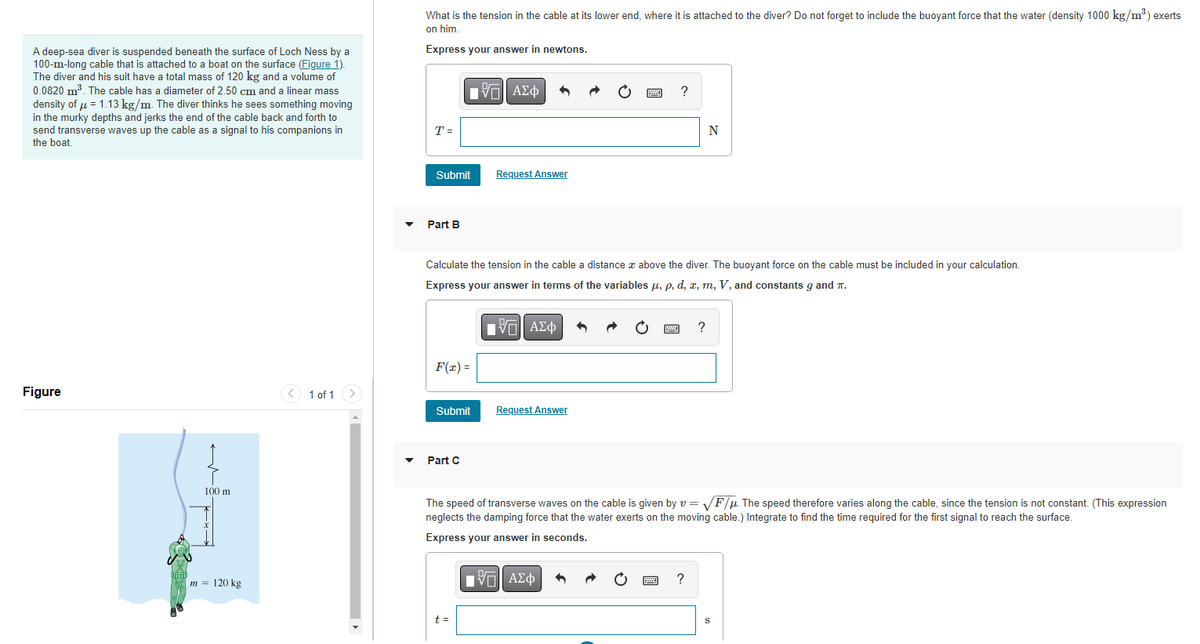Figure 1 100 m m= 120 kg < 1 of 1 > Part B Calculate the tension in the cable a distance z above the diver. The buoyant force on the cable must Express your answer in terms of the variables µ, p, d, z, m, V, and constants g and T. 15| ΑΣΦ F(x)= Submit Part C Request Answer → C M ? The speed of transverse waves on the cable is given by v=√F/μ. The speed therefore varies along the cable, since the tension is not constant. (This expres neglects the damping force that the water exerts on the moving cable.) Integrate to find the time required for the first signal to reach the surface. Express your answer in seconds. IVE ΑΣΦ ? included in your calculation. S
Figure 1 100 m m= 120 kg < 1 of 1 > Part B Calculate the tension in the cable a distance z above the diver. The buoyant force on the cable must Express your answer in terms of the variables µ, p, d, z, m, V, and constants g and T. 15| ΑΣΦ F(x)= Submit Part C Request Answer → C M ? The speed of transverse waves on the cable is given by v=√F/μ. The speed therefore varies along the cable, since the tension is not constant. (This expres neglects the damping force that the water exerts on the moving cable.) Integrate to find the time required for the first signal to reach the surface. Express your answer in seconds. IVE ΑΣΦ ? included in your calculation. S
Related questions
Question

Transcribed Image Text:A deep-sea diver is suspended beneath the surface of Loch Ness by a
100-m-long cable that is attached to a boat on the surface (Figure 1).
The diver and his suit have a total mass of 120 kg and a volume of
0.0820 m³. The cable has a diameter of 2.50 cm and a linear mass
density of μ = 1.13 kg/m. The diver thinks he sees something moving
in the murky depths and jerks the end of the cable back and forth to
send transverse waves up the cable as a signal to his companions in
the boat.
Figure
100 m
m = 120 kg
1 of 1
What is the tension in the cable at its lower end, where it is attached to the diver? Do not forget to include the buoyant force that the water (density 1000 kg/m³) exerts
on him.
Express your answer in newtons.
T =
Submit
Part B
IVE ΑΣΦ
F(x) =
Submit
Part C
Calculate the tension in the cable a distance above the diver. The buoyant force on the cable must be included in your calculation.
Express your answer in terms of the variables μ, p, d, x, m, V, and constants g and T.
VE ΑΣΦ
Request Answer
t=
?
Request Answer
N
The speed of transverse waves on the cable is given by v = =√F/μ. The speed therefore varies along the cable, since the tension is not constant. (This expression
neglects the damping force that the water exerts on the moving cable.) Integrate to find the time required for the first signal to reach the surface.
Express your answer in seconds.
VE ΑΣΦ
?
S
Expert Solution
This question has been solved!
Explore an expertly crafted, step-by-step solution for a thorough understanding of key concepts.
This is a popular solution!
Trending now
This is a popular solution!
Step by step
Solved in 5 steps with 1 images
